So, I decided to skip the spring turkey hunt this year. Not because of my mixed success at shooting birds with brains the size of peas, as some ill-spirited mockers might say, but because I’m actually not all that thrilled by the possibilities that their meat offers in the kitchen. The taste of wild turkey, while certainly more pronounced than that of the overweight flightless birds found in the supermarket, is nothing to go crazy about. The white meat is lean and pretty tough. The legs are fine when cooked for a long time, just like duck legs (see my confit recipes here and here, for example), and given the choice, I’d pick duck (even farmed) over turkey any day. And I’d also pick duck hunting over turkey hunting any day — it’s a lot more fun.
In lieu of the hunt, I’ve been rediscovering D’Artagnan‘s fabulous selection of wild Scottish game, including hare, grouse, partridge, and pheasant. I’ve purchased these products regularly over the years, though less frequently in the recent past, and many game recipes have been posted on this blog — just check out the Small Game page. Today’s entry looks a bit similar to my Pheasant à la Russe, but with a few important differences: 1) It’s a spring recipe, with lots of vegetables instead of the heavy smitane sauce; 2) The ground meat goes inside the boned bird, not the other way around; and 3) It’s a much more complex and accomplished dish.
This recipe symbolizes, for me, the transition between hunting season and true spring. “But what makes it Eastern European?”, you might ask. I could just point at the two kinds of potatoes and the bacon bits, you silly. But there’s more. In most of Eastern Europe, mushroom gathering is still far more widespread than in the West, and few species are as prized as morels. Just read this blog post by Dumneazu (which talks about ramps too!). Pheasants are equally widespread, in both the mountain ranges and the lowlands of Central Europe, and pheasant hunting traditions are well-established. As for the fava beans? I found them in my beloved Czech Cuisine: A Modern Approach!
Stuffed pheasant
Yields over 6 servings
2 wild Scottish pheasants, about 750-800 g each
45 g white bread without crust, small dice
30 g butter
6 g salt
0.3 g black pepper, ground
5 g parsley, chopped
7 g Armenian brandy (or cognac)
transglutaminase (optional)
- Take the largest pheasant. Cut off the wings and drumsticks, and reserve for stock. Position the bird on its breast, and separate the meat from the carcass, starting from the middle. Once you’re done, the breast and thighs should still be attached together as one (you can watch this video to get a better idea of how it should be done.) Remove the thigh bones and any other tiny, thin leg bones. Reserve the carcass, bones, wings, and drumsticks for stock.
- Cut the smaller pheasant into 8 pieces — 2 each of breasts, thighs, legs, and wings. Pick the meat from the thighs, legs, and wings, and add some of the breast meat until you have 350 g (you can also include the liver and some of the skin and fat). Grind the meat using the large die of a meat grinder. Reserve the remaining pheasant breast meat.
- In a small pan over medium heat, sauté the diced bread in the butter until golden brown. Let cool.
- Mix the ground pheasant, salt, black pepper, parsley, and brandy in a bowl. Grind this stuffing mixture using the small die of a meat grinder, then return to the bowl, and mix in the diced bread.
- Arrange the boned pheasant skin-side down on a sheet of plastic film. Add the breast meat from the smaller pheasant in order to form a rectangle of about 22 cm x 18 cm, of even thickness (see photo below). Optionally, sprinkle with transglutaminase to bind.
- Shape the stuffing into a cylinder, and arrange along the longer side of the pheasant rectangle. Wrap the meat around the stuffing, and tightly wrap in several layers of plastic film (the first layer is usually pretty loose, the next get tighter). Place the stuffed pheasant into a sous-vide pouch, and vacuum-seal.
- Cook in a 60 C / 140 F water bath for 3 hours. Reserve.
Morel coulis
Yields about 6 servings
65 g raw duck foie gras
salt
150 g fresh morels
30 g butter
30 g peeled onion, small dice
200 g pheasant stock (or chicken stock)
130 g heavy cream
- Season the foie gras with salt. Sauté in a hot pan until dark brown on both sides, then reserve.
- Rinse the morels thoroughly under cold water, and slice. In a saucepan over medium heat, melt the butter, then sauté the morels with the onion for 5 minutes, until soft.
- Add the stock, and simmer for 5 minutes. Add the cream, and reduce to 400 g, stirring occasionally.
- Transfer to a blender, and process on high speed for 2 minutes. Rectify the seasoning, add the foie gras, and blend for another 30 seconds. Pass through a chinois, and reserve.
Scallion and ramp purée
Yields over 6 servings
25 g peeled onion, sliced
10 g butter
35 g scallion greens
30 g ramp greens
salt
1 pinch baking soda
3 g parsley leaves
black pepper, ground
10 g lemon juice
30 g sliced almonds, finely chopped
- In a pan over medium heat, sauté the onion in the butter until soft.
- Cook the scallion and ramp greens together in a pot of salted boiling water with the baking soda until soft. Use a skimmer to remove the scallion and ramp greens from the pot, and squeeze to remove some of the water. Reserve. Then boil the parsley in the same pot of water until soft.
- Transfer the onion, scallion and ramp greens, and parsley to a blender, then process until smooth. Rectify the seasoning, and transfer to a bowl.
- Mix in the lemon juice and the chopped almonds, and reserve (If you do this step just before assembling the complete dish, the purée should stay bright green for service).
Spring vegetables
Yields about 6 servings
16 fresh medium-sized morels, cleaned
salt
400 g peeled fingerling potatoes of various colors
170 g shelled fava beans (about 500 g beans in the pods)
50 g scallion whites, 4-5 cm long
40 g ramp whites, 4-5 cm long
80 g butter
- Place the morels into a small saucepan with a little bit of water, season with salt, cover, and cook over medium heat until soft. Drain and reserve.
- Cook the potatoes in a pot of salted boiling water until done. Remove from the pot and reserve.
- In the same water, cook the fava beans until tender, then shock in a bath of ice water. Peel the beans, and reserve.
- Place the scallion and ramp whites with 1/2 of the butter and about the same amount of water in a small saucepan. Season with salt, cover, and cook over the lowest heat setting for about 25 minutes, until tender. Remove from the heat, and let cool.
- Combine the morels, potatoes, fava beans, scallions, ramps, and the rest of the butter, and reserve.
Fried potato bits
Yields about 6 servings
200 g peeled Idaho potato
canola oil (for deep-frying)
- Grate the potato using the small holes of a cheese grater.
- Heat the canola oil to 200 C / 375 F in a deep-fryer (or a large pot). Deep-fry the grated potatoes until golden brown, then drain on paper towels, and reserve.
Fried bacon bits
Yields about 6 servings
75 g bacon, brunoise
- Sauté the bacon in a pan over medium heat until brown and crispy. Drain on paper towels, and reserve.
Assembly
Yields about 6 servings
stuffed pheasant
morel coulis
15 g butter
15 g canola oil
spring vegetables
scallion and ramp purée, room temperature
fried potato bits
fried bacon bits
- Take the stuffed pheasant out of the sous-vide pouch, and season generously with salt. Mix the cooking juices with the morel coulis, and keep warm in a small saucepan.
- Mix the butter and canola oil in a pan over medium heat. Add the stuffed pheasant, and sauté, turning until brown on all sides. Remove from the heat, let rest for a minute, then cut into 6 thick slices.
- Reheat the spring vegetables in a small saucepan over medium heat.
- In each bowl, pour enough morel coulis to cover the bottom, then place a slice of pheasant in the center. Arrange some spring vegetables around the meat, along with a couple teaspoons of scallion and ramp purée. Top the pheasant with some fried potato bits, and sprinkle some bacon bits around the plate. Serve immediately.

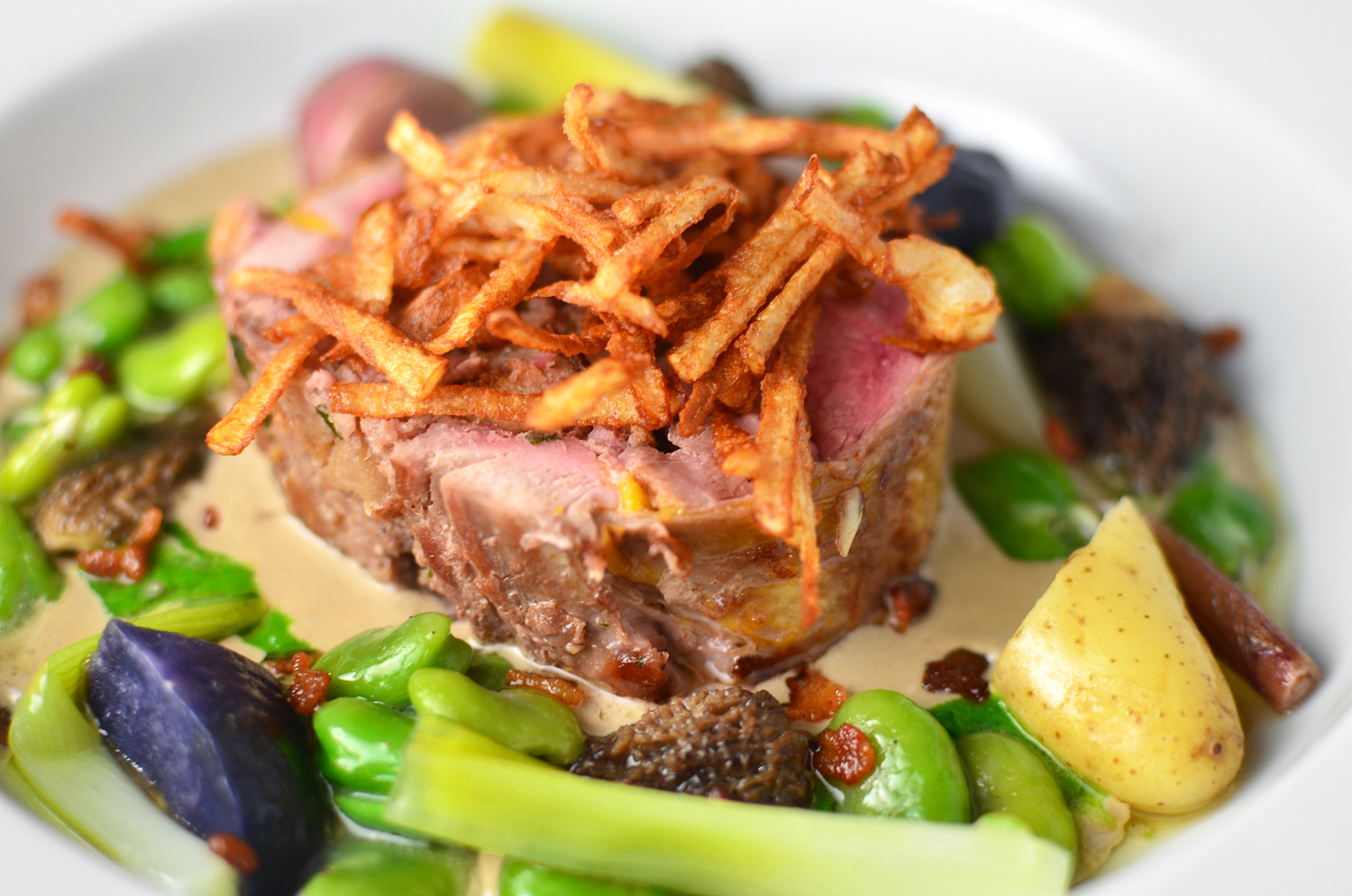
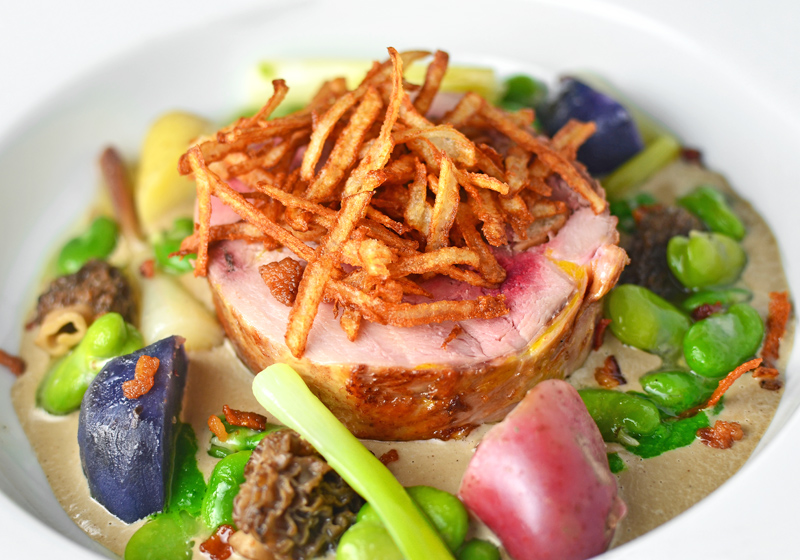
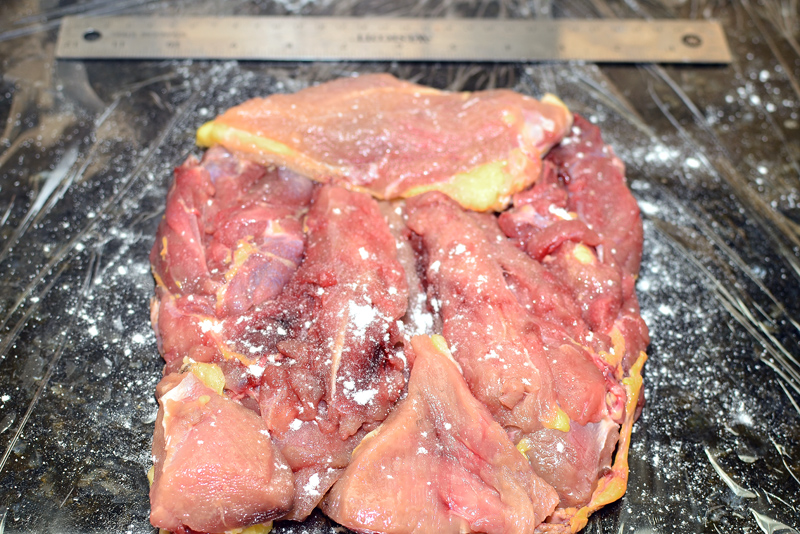
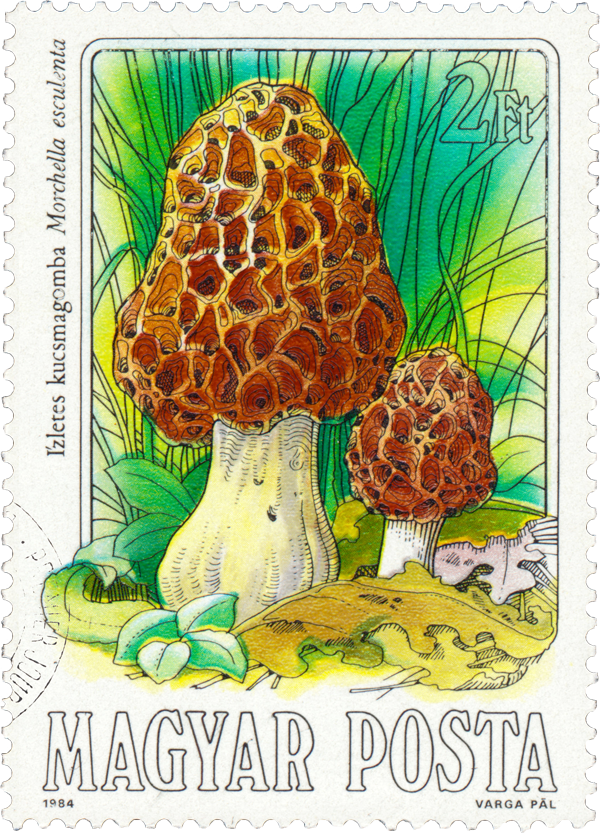
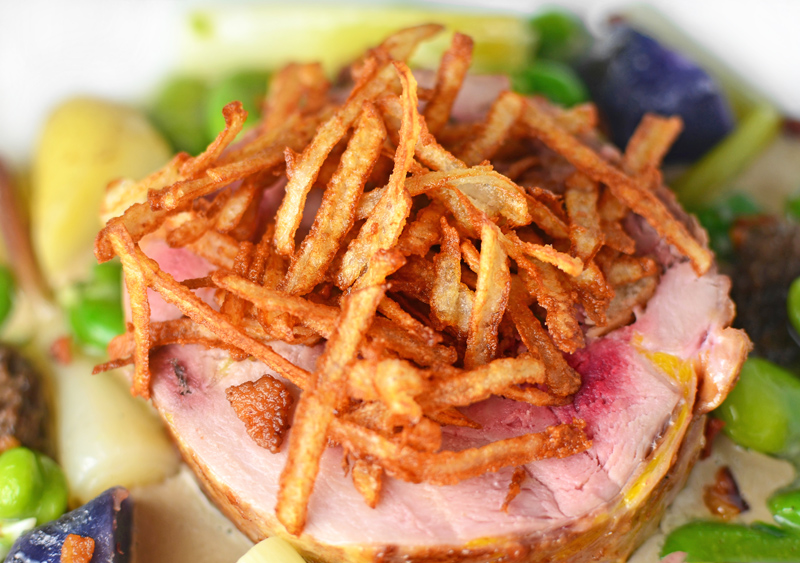
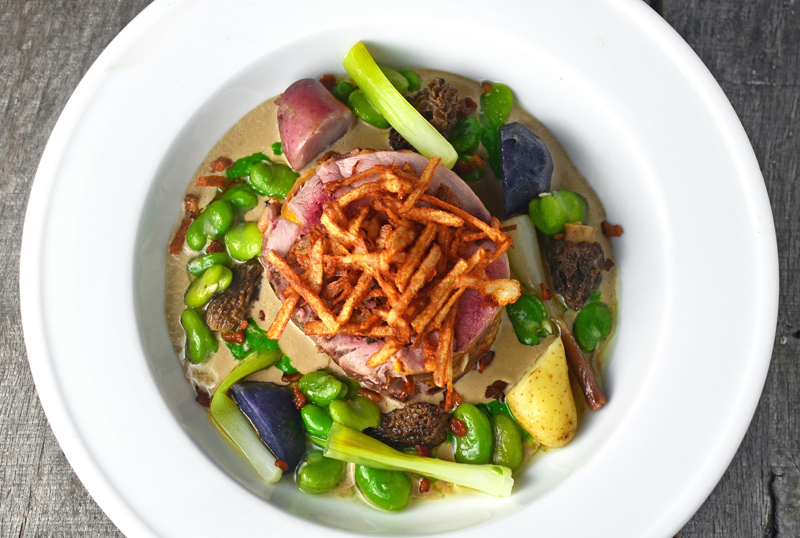
2 comments
Delicious! I want to try this
The photos make me go hungry. Thanks a lot for posting.